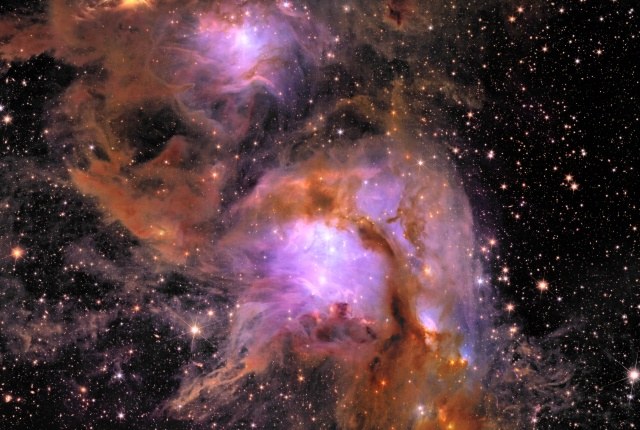The first extraordinary images from the Euclid space telescope
Obtained from a single day of observations, the first snapshots are at least four times sharper than those obtained with terrestrial telescopes and cover large portions of the sky at an unparalleled depth
This breathtaking image shows Messier 78, a vibrant nursery of star formation enveloped in a shroud of interstellar dust. Euclid peered deep into this enshrouded nursery using its infrared camera, exposing hidden regions of star formation for the first time, mapping its complex filaments of gas and dust in unprecedented detail, and uncovering newly formed stars and planets (Image: ESA/Euclid/Euclid Consortium/NASA, image processing by J.-C. Cuillandre (CEA Paris-Saclay), G. Anselmi; CC BY-SA 3.0 IGO or ESA Standard Licence)
From nearby clouds of gas and dust to distant clusters of galaxies, individual stellar populations, and rogue planets moving freely through space, the first images captured by the Euclid space telescope are truly unprecedented.
Less than a year after its departure, the mission led by the European Space Agency - ESA, to which the University of Bologna is also contributing, presents us with its first results: images that are not only visually stunning, but also reveal new physical properties of the Universe, described in detail in a series of new scientific articles.
In this image, Euclid shows NGC 6744, an archetypal galaxy that currently forms the majority of stars in the local Universe. Euclid's wide field of view covers the entire galaxy, capturing not only the magnificent spiral structure but also exquisite details on smaller spatial scales (Image: ESA/Euclid/Euclid Consortium/NASA, image processing by J.-C. Cuillandre (CEA Paris-Saclay), G. Anselmi; CC BY-SA 3.0 IGO or ESA Standard Licence)
Euclid produced this first catalogue of data in just one day of observations, revealing more than 11 million objects in visible light and another 5 million in infrared light. The complete set of first observations covered 17 astronomical objects, from nearby clouds of gas and dust to distant galaxy clusters.
These first images are at least four times sharper than those obtained with terrestrial telescopes and cover large portions of the sky at an unparalleled depth. These results show the extraordinary capabilities of Euclid, which is able to identify, in star-forming regions, “rogue” planets moving freely in space, with a mass just four times that of Jupiter, or to study the outer regions of star clusters in unprecedented detail, or again to map various stellar populations so as to explore how galaxies have evolved over time.
Here, Euclid captured the group of galaxies called Dorado. Galaxies evolve and merge, generating beautiful star tails due to gravitational interactions. Scientists use this type of data to study how galaxies evolve, to improve our models of cosmic history and to understand how galaxies form inside dark matter halos (Image: ESA/Euclid/Euclid Consortium/NASA, image processing by J.-C. Cuillandre (CEA Paris-Saclay), G. Anselmi; CC BY-SA 3.0 IGO or ESA Standard Licence)
In short, the ESA mission has all the makings of achieving its main objective: to unlock the secrets of the dark Universe and reveal how and why the Universe looks the way it does today. Indeed, Euclid will trace the hidden foundations of the cosmos, mapping billions of galaxies across about a third of the sky, exploring how our Universe formed and evolved, and studying the most mysterious of its fundamental components: dark energy and dark matter.
"The data collected by Euclid will also allow us to study in detail the physical properties of galaxies during a particularly interesting and activity-rich period in the Universe's life," adds Margherita Talia, a researcher at the Department of Physics and Astronomy "Augusto Righi" at the University of Bologna, who is participating in the mission. "While we will have to wait until the end of the mission for answers to the cosmological questions, the first significant results on the evolution of galaxies will arrive as early as next year, and our Department is at the forefront of this field of research as well. The first images released today are just a small taste of Euclid's legacy value, but the coming months promise to be even more exciting and full of discoveries".
Euclid’s cutout view of the Abell 2390 galaxy cluster also shows the faint ‘intracluster light’ emitted by stars that have been ripped away from their parent galaxies into intergalactic space. Viewing this light is a specialty of Euclid, and these stellar orphans may allow us to ‘see’ where dark matter lies (Image: ESA/Euclid/Euclid Consortium/NASA, image processing by J.-C. Cuillandre (CEA Paris-Saclay), G. Anselmi; CC BY-SA 3.0 IGO or ESA Standard Licence)
“Euclid demonstrates European excellence in frontier science and state-of-the-art technology, and showcases the importance of international collaboration", - says ESA Director Josef Aschbacher - The mission is the result of many years of hard work from scientists, engineers and industry throughout Europe and from members of the Euclid scientific consortium around the world, all brought together by ESA. They can be proud of this achievement – the results are no small feat for such an ambitious mission and such complex fundamental science. Euclid is at the very beginning of its exciting journey to map the structure of the Universe”.
Built and managed by the European Space Agency (ESA), Euclid was created with the contribution of NASA and the Italian collaboration of the Italian Space Agency (ASI), the National Institute of Astrophysics (INAF), the National Institute of Nuclear Physics (INFN) and several Italian universities, including the University of Bologna.




